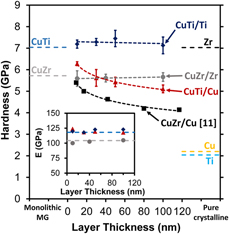Crossref Citations
This article has been cited by the following publications. This list is generated based on data provided by
Crossref.
Abboud, Mohammad
Motallebzadeh, Amir
Duygulu, Özgür
Maaß, Robert
and
Özerinç, Sezer
2021.
Microstructure and nanomechanical behavior of sputtered CuNb thin films.
Intermetallics,
Vol. 136,
Issue. ,
p.
107249.
Ji, Guoning
Xiang, Jun
Wei, Jingsong
Chen, Minghua
Zhao, Rongda
Wu, Xiaofeng
Chen, Shunhua
and
Wu, Fufa
2022.
Enhancement of tensile plastic stability of Ti-based metallic glass composite with substrate of titanium alloy.
Journal of Alloys and Compounds,
Vol. 920,
Issue. ,
p.
165916.
Tang, Jian-Fu
Huang, Po-Yuan
Lin, Ja-Hon
Liu, Ting-Wei
Yang, Fu-Chi
and
Chang, Chi-Lung
2022.
Microstructure and Antimicrobial Properties of Zr-Cu-Ti Thin-Film Metallic Glass Deposited Using High-Power Impulse Magnetron Sputtering.
Materials,
Vol. 15,
Issue. 7,
p.
2461.
Behboud, Ali B.
Motallebzadeh, Amir
and
Özerinç, Sezer
2022.
Nanoheterogeneous ZrTa metallic glass thin films with high strength and toughness.
Journal of Alloys and Compounds,
Vol. 901,
Issue. ,
p.
163578.
Okuyucu, Can
Ulucan, Tolga Han
Abboud, Mohammad
Motallebzadeh, Amir
Özerinç, Sezer
Kalay, İlkay
and
Kalay, Yunus Eren
2023.
Nanomechanical properties of Al-Tb marginal metallic glass.
Materials Science and Engineering: A,
Vol. 888,
Issue. ,
p.
145809.
Piirsoo, Helle-Mai
Jõgiaas, Taivo
Kukli, Kaupo
and
Tamm, Aile
2023.
Influence of Annealing on Mechanical Behavior of Alumina-Tantala Nanolaminates.
Materials,
Vol. 16,
Issue. 8,
p.
3207.
Hwang, Gyeong-Seok
Bae, Jae-Young
Kim, Joon-Woo
Park, Sun-Young
Kim, Jeonghyun
Kang, Seung-Kyun
and
Kim, Ju-Young
2023.
Highly Elastic and Conductive Metallic Interconnect with Crystalline–Amorphous Nanolaminate.
ACS Applied Materials & Interfaces,
Vol. 15,
Issue. 12,
p.
15863.
Behboud, Ali B.
Fadaie, Amir
Motallebzadeh, Amir
Şehirli, Servet
and
Özerinç, Sezer
2024.
Effect of nanoheterogeneities on the fracture toughness and tensile ductility of CuTa metallic glass thin films.
Journal of Alloys and Compounds,
Vol. 979,
Issue. ,
p.
173331.
Qin, Feng
Chen, Feihu
Hou, Junhua
Lu, Wenjun
Chen, Shaohua
and
Li, Jianjun
2024.
Strong resistance to shear instability in multilayered metallic composites by nanoscale amorphous-BCC crystalline interfaces.
Materials Science and Engineering: A,
Vol. 891,
Issue. ,
p.
145919.
Dai, Kaiqing
Zhang, Chun
and
Li, Jianjun
2024.
Shear banding suppression in Cu/TiZrNb nanolayered composites through dual crystalline/amorphous interfaces.
Materials Today Communications,
Vol. 38,
Issue. ,
p.
108481.
Chen, Yangheng
Wang, Yaodong
and
Li, Jianjun
2024.
Size-dependent atomic strain localization mechanism in Nb/amorphous CuNb nanolayered composites.
Journal of Applied Physics,
Vol. 136,
Issue. 20,
